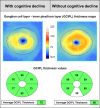Retinal thickness predicts the risk of cognitive decline over five years
- PMID: 39716304
- PMCID: PMC11664827
- DOI: 10.1186/s13195-024-01627-0
Retinal thickness predicts the risk of cognitive decline over five years
Abstract
Background: Dementia poses a significant burden on healthcare systems. Early identification of individuals at risk for cognitive decline is crucial. The retina, an extension of the central nervous system, reflects neurodegenerative changes. Optical coherence tomography (OCT) is a non-invasive tool for assessing retinal health and has shown promise in predicting cognitive decline. However, prior studies produced mixed results.
Methods: This study investigated a large cohort (n = 490) of Asian individuals attending memory clinics. Participants underwent comprehensive neuropsychological testing annually for five years. Retinal thickness was measured by OCT at baseline. We assessed the association between baseline retinal thickness and subsequent cognitive decline.
Results: Participants with a significantly thinner macular ganglion cell-inner plexiform layer (GCIPL) at baseline (≤ 79 μm) had a 38% greater risk of cognitive decline compared to those who did not (≥ 88 μm; p = 0.037). In a multivariable model accounting for age, education, cerebrovascular disease status, hypertension, hyperlipidemia, diabetes and smoking, thinner GCIPL was associated with an increased risk of cognitive decline (hazard ratio = 1.14, 95% CI = 1.01-1.30, p = 0.035). Retinal nerve fiber layer (RNFL) thickness was not associated with cognitive decline.
Conclusions: This study suggests that OCT-derived macular GCIPL thickness may be a valuable biomarker for identifying individuals at risk of cognitive decline. Our findings highlight GCIPL as a potentially more sensitive marker compared to RNFL thickness for detecting early neurodegenerative changes.
Trial registration number and name of the trial registry: National Healthcare Group Domain-Specific Review Board (NHG DSRB) reference numbers DSRB Ref: 2018/01368. Name of the trial: Harmonisation project.
Keywords: Cognitive decline; Cognitive impairment; Dementia; Optical coherence tomography (OCT); Retinal ganglion cell-inner plexiform layer (GCIPL).
© 2024. The Author(s).
Conflict of interest statement
Declarations. Ethics approval and consent to participate: This study was approved by the National Healthcare Group Domain-Specific Review Board (NHG DSRB reference number 2018/01098 and 2010/00017). The study adhered to the tenets of the Declaration of Helsinki and its later amendments. Study coordinators obtained written informed consent from all participants or legal representatives before their study inclusion. Consent for publication: Not applicable. Competing interests: The authors declare no competing interests.
Figures



Similar articles
-
Ganglion cell-inner plexiform layer and retinal nerve fibre layer changes within the macula in retinitis pigmentosa: a spectral domain optical coherence tomography study.Acta Ophthalmol. 2018 Mar;96(2):e180-e188. doi: 10.1111/aos.13577. Epub 2017 Nov 2. Acta Ophthalmol. 2018. PMID: 29098796
-
Ganglion cell-inner plexiform layer and retinal nerve fiber layer thickness according to myopia and optic disc area: a quantitative and three-dimensional analysis.BMC Ophthalmol. 2017 Mar 11;17(1):22. doi: 10.1186/s12886-017-0419-1. BMC Ophthalmol. 2017. PMID: 28283025 Free PMC article.
-
Visualization of Focal Thinning of the Ganglion Cell-Inner Plexiform Layer in Patients with Mild Cognitive Impairment and Alzheimer's Disease.J Alzheimers Dis. 2018;64(4):1261-1273. doi: 10.3233/JAD-180070. J Alzheimers Dis. 2018. PMID: 30040712
-
Optical coherence tomography in mild cognitive impairment - Systematic review and meta-analysis.Clin Neurol Neurosurg. 2020 Sep;196:106036. doi: 10.1016/j.clineuro.2020.106036. Epub 2020 Jun 22. Clin Neurol Neurosurg. 2020. PMID: 32623211
-
Spectral-Domain OCT Measurements in Alzheimer's Disease: A Systematic Review and Meta-analysis.Ophthalmology. 2019 Apr;126(4):497-510. doi: 10.1016/j.ophtha.2018.08.009. Epub 2018 Aug 13. Ophthalmology. 2019. PMID: 30114417 Free PMC article.
Cited by
-
Recent Optical Coherence Tomography (OCT) Innovations for Increased Accessibility and Remote Surveillance.Bioengineering (Basel). 2025 Apr 23;12(5):441. doi: 10.3390/bioengineering12050441. Bioengineering (Basel). 2025. PMID: 40428060 Free PMC article. Review.
References
-
- International Alzheimer’s Disease AD. World Alzheimer Report. 2023: Reducing Dementia Risk: Never too early, never too late. 2023 [cited 2024 Apr 1]; https://www.alzint.org/resource/world-alzheimer-report-2023/
-
- WHO WHO. Dementia. WHO fact sheet on dementia. 2024 [cited 2024 Mar 11]. https://www.who.int/news-room/fact-sheets/detail/dementia
-
- Comas-Herrera A, Guerchet M, Karagiannidou M, Knapp M, Prince M, World Alzheimer R. 2016: Improving healthcare for people living with dementia: Coverage, quality and costs now and in the future. 2016 [cited 2024 Apr 1]; https://www.alzint.org/resource/world-alzheimer-report-2016/
-
- International Alzheimer’s Disease. World Alzheimer Report 2015: The global impact of dementia: An analysis of prevalence, incidence, cost and trends. 2015 [cited 2024 Apr 1]; https://www.alzint.org/resource/world-alzheimer-report-2015/
-
- International Alzheimer’s Disease. World Alzheimer Report 2021: Journey through the diagnosis of dementia. 2021 [cited 2024 Apr 1]; https://www.alzint.org/resource/world-alzheimer-report-2021/
MeSH terms
Grants and funding
- OFLCG/004c/2018-00; MOH-000249-00; MOH-000647-00; MOH-001001-00; MOH-001015-00; MOH-000500-00; MOH-000707-00; MOH-001072-06; MOH-001286-00/National Medical Research Council
- OFLCG/004c/2018-00; MOH-000249-00; MOH-000647-00; MOH-001001-00; MOH-001015-00; MOH-000500-00; MOH-000707-00; MOH-001072-06; MOH-001286-00/National Medical Research Council
- OFLCG/004c/2018-00; MOH-000249-00; MOH-000647-00; MOH-001001-00; MOH-001015-00; MOH-000500-00; MOH-000707-00; MOH-001072-06; MOH-001286-00/National Medical Research Council
- NRF2019-THE002-0006 and NRF-CRP24-2020-0001/National Research Foundation Singapore
- A20H4b0141/Agency for Science, Technology and Research
LinkOut - more resources
Full Text Sources
Medical
Research Materials

